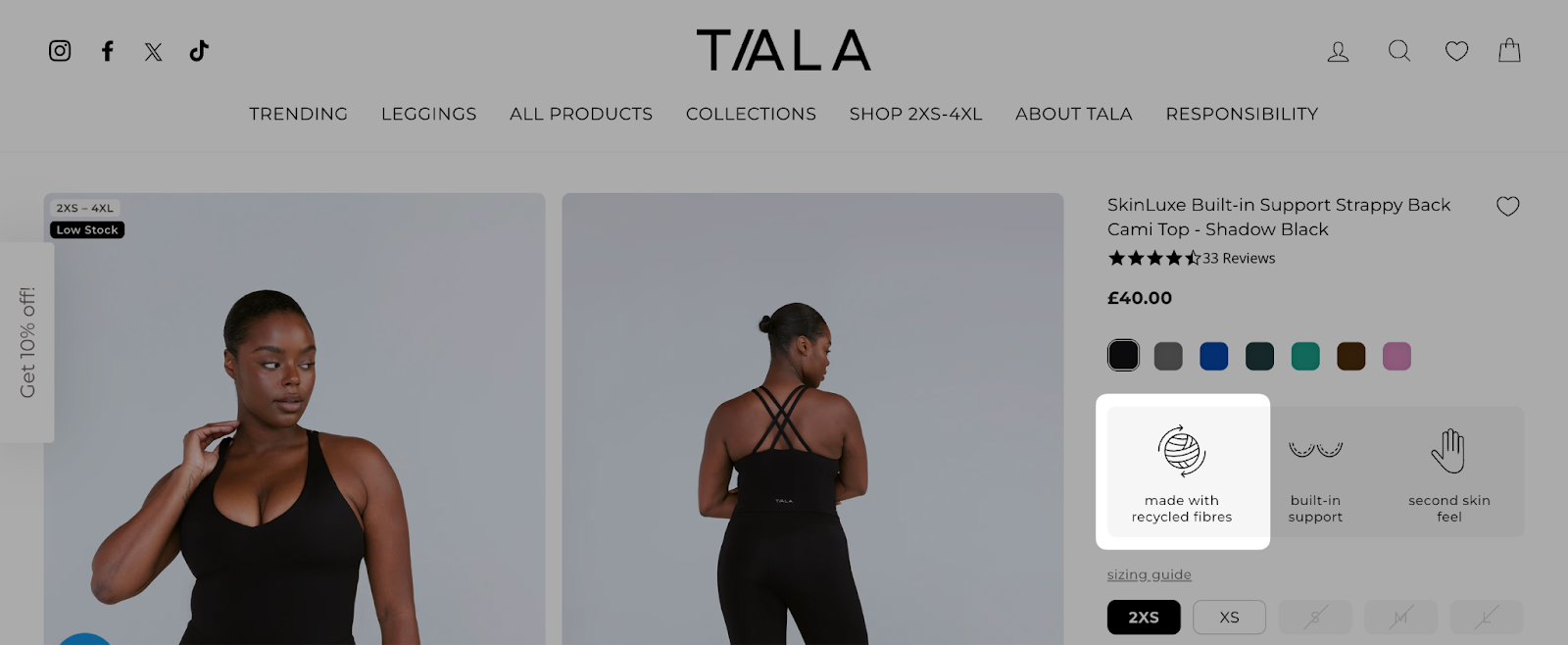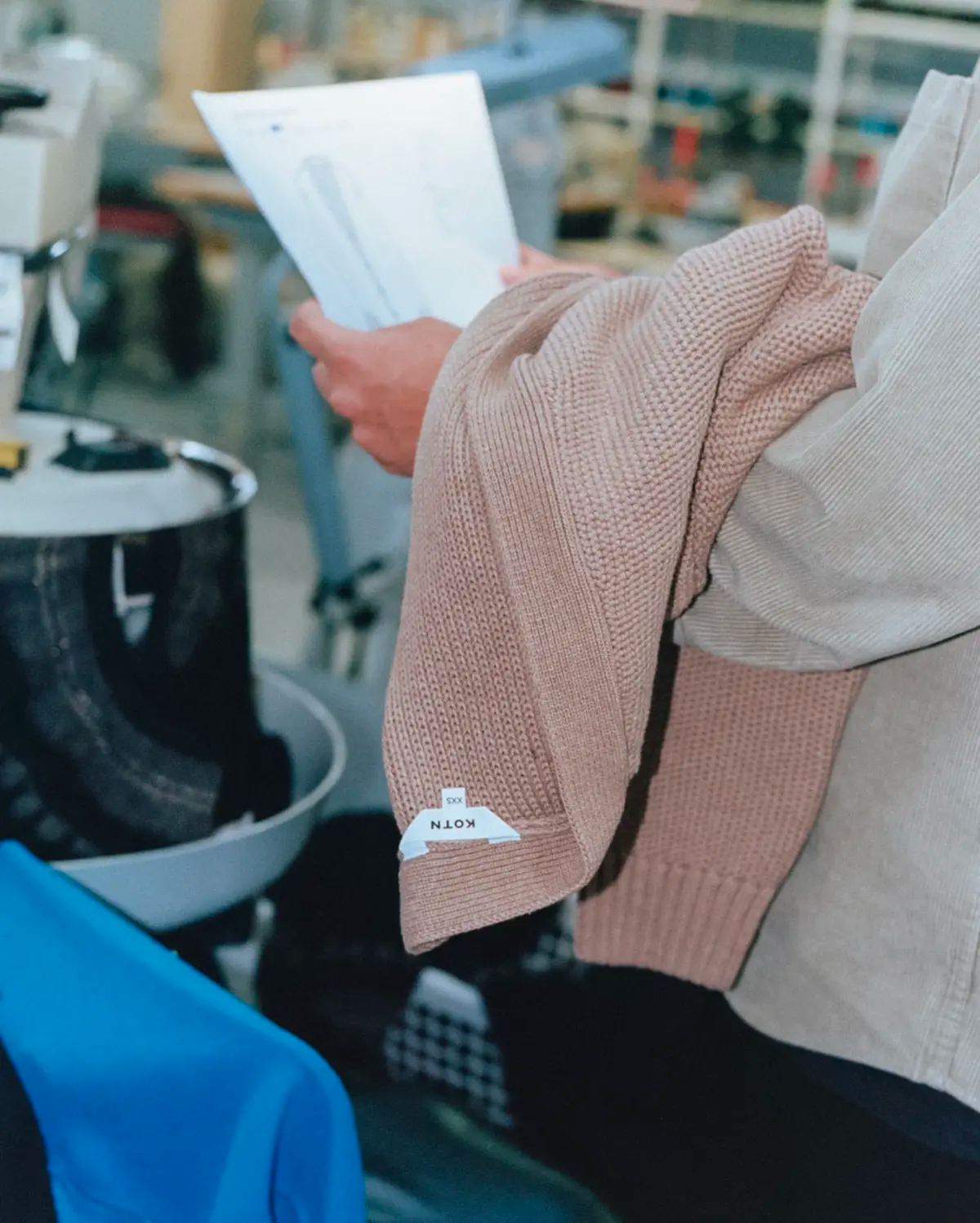New consumer behaviors predicated on values are steadily reshaping the future of commerce. According to Deloitte’s sustainability report, one in 10 customers will make a purchase decision based on carbon footprint data availability. Some 25% say they would pay more for brands that commit to environmentally sustainable and ethical practices.
These preferences are contributing to a global sustainable fashion market that is expected to reach $33.05 billion by 2030. Consumers are ready for this investment—they have environmental concerns and want to reduce their carbon footprint while feeling good about the brands they support.
As the demand for sustainable products continues to rise, global preference and greater investment in sustainable business have an opportunity to meet that demand. This guide explores the different sustainable fashion business models and how to make your clothing brand more sustainable, from the supply chain to product packaging.
What is sustainable fashion?
Sustainable fashion refers to garments that are designed, produced, and distributed with consideration for the environment, society, and economy.
Also known as “green fashion”, it aims to create a more circular fashion system that reduces waste and water pollution, uses natural and renewable materials, and provides fair working conditions.
The sustainable fashion industry is growing rapidly, particularly online as consumers are becoming increasingly aware of the unsustainable lifecycle a piece of clothing must go through before it lands in their hands.
Why is sustainable fashion important?
Sustainability is important in fashion because it can help to reduce the negative environmental impact of the ecommerce fashion industry, while also helping to create better social and economic outcomes.
These Entrepreneurs Are Reversing Climate Change
Greenhouse gas emissions
Some studies estimate that the fashion industry is responsible for up to 10% of global carbon emissions. That’s more than aviation and shipping combined.
All clothing must go through rigorous manufacturing processes before it’s wearable. Materials like cotton require land (about 2.5% of all farmland); synthetic materials need about 342 million barrels of oil every year.
And for many suppliers, the machinery they’re operating to produce clothes emit greenhouse gasses like CO2 into the earth’s atmosphere, which contributes to global warming.
Excess waste
Although strides are being made in the world of recycling, the fashion industry is falling behind. Just 12% of the material used for clothing ends up being recycled.
And it’s not just the process of producing garments that causes problems. At the opposite end of the spectrum, estimate that of the 100 billion garments produced each year, 92 million tonnes end up in landfills. In other words: the already unsustainable practices we use to manufacture clothing are going to waste (literally).
Water usage and pollution
The fashion industry uses more water than meat production, beverage, and automotive manufacturing industries.
Clothing companies are the second-biggest industrial consumers of water—which is hardly surprising considering how much water is needed for washing clothes and manufacturing. Take the humble t-shirt, for example, which needs 2,700 liters of water to produce. That’s enough for one person to drink for 900 days.
Of the water that makes it out the other end, the vast majority is polluted by dyes and microplastics. Fashion brands use enough water in the dyeing process alone to fill two million Olympic-sized swimming pools every year. But this water isn’t dumped into pools. Polluted water and toxic chemicals make their way into our waters, which harms marine life, spreads disease, and contaminates the food chain.
Cheap materials like polyester and cotton also contain microplastics—small shards of plastic up to five millimeters in diameter—that pull away from garments when they’re washed and dried. Much like dyes, these microplastics don’t break down. They enter our waterways, then into our bodies, to cause a host of health problems.
Types of sustainable fashion business models
Fashion rental
The global online clothing rental industry will be worth $2.33 billion by 2030. And it’s not just expensive garments that people are renting; fast fashion brands like H&M and ASOS have launched rental services that allow people to wear a garment and return it for a smaller fee than buying it outright.
The rental business model is inherently more sustainable than traditional commerce. Instead of selling individual items each time, you’re renting the same garment to multiple people. This reduces waste since the garment only needs to be manufactured once, which saves water and cuts down greenhouse gas emissions.
Rental can also act as a barrier against return fraud. Fashion consumers are notorious for buying clothing, wearing it for a special occasion, and returning it for a full refund. This business model charges people for the convenience of one-time wear.
Preloved fashion
Preloved fashion happens when people buy products that someone else no longer needs. The sustainable business model is a win-win for everyone involved: customers get cash for products they no longer need, the product doesn’t end up in landfill, and deal-hunting shoppers get the best price.
Popular amongst socially responsible shoppers, the apparel resale market will generate $351 billion by 2027. Consumers’ openness to clothing swaps and buying old clothes has paved the way for online fashion sites like Vinted, Poshmark, and Depop to sell clothes more sustainably.
Consignment service Luxe Collective even buys its inventory from people selling their old luxury goods, rather than sourcing products directly from manufacturers. The brand simply takes commission between 15% and 40% of the resale price.

Luxe Collective’s consignment commission structure.
Made to order clothing
Fashion production is resource intensive. Limit how much you’re contributing to water usage and waste by only producing garments when they’ve been ordered. Designer Patrick McDowell uses this model to lure in Gen Z customers who are particularly interested in the intersection of luxury fashion and sustainability.
The difficulty with this business model is that turnaround times will be longer and sometimes more expensive since you may not qualify for bulk discounts. Yet this might not be as big of a challenge as you might think—people pay premiums for sustainability in fashion. If you can communicate that garments might take a little longer to arrive because they’re custom made, there’s a good chance that you’ll still convert eco-conscious shoppers.
How to more your fashion brand more sustainable
1. Lean on renewable energy sources
Sewing machines, warehouses, and washing machines all need power. Nonrenewable energy sources like coal, oil, and gas all emit finite (once they’re gone, they’re gone). They’re incredibly unsustainable—burning them causes CO2 to enter the atmosphere and contributes to global warming.
Use renewable sources like wind and solar to power your fashion business instead. If you’re operating a large warehouse, for example, you could install solar panels on the roof to turn the sun’s energy into electricity. You won’t emit any greenhouse gasses from doing so, which makes your fashion brand more sustainable while also reducing utility bills.
2. Use sustainable materials
Waste is a huge problem for the fashion industry. Most textiles—including acrylic and polyester—contain microplastics. When people dispose of their garments (or you throw out inventory that’s no longer in demand), the miniature fibers from your clothing come out and take thousands of years to break down, polluting our environment in the meantime.
Making your fashion brand more sustainable starts with the raw materials you’re using to manufacture garments. Forgo microplastics and harmful dyes in favor of natural materials like organic cotton, linen, hemp, and bamboo, which are much easier to break down and recycle.
The same concept applies to your packaging and marketing materials. Whether it’s “thanks for your order!” notes or protective bags to seal your garments for delivery, choose biodegradable materials when packaging. Paper, cardboard, and bamboo are popular eco-friendly options since they can be easily recycled by your customers at home.

Allbirds uses eco-friendly packaging made with 90% post-consumer cardboard.
3. Recycle clothing returns
Returns plague all online retailers, but those in the fashion industry often take the biggest hit. Studies estimate that 26% of all online-bought clothes are later returned. Reasons for these returns include the item not fitting (75%), the garment didn’t match the description (56%), and ordering multiple sizes (14%).
The problem is: Not all returns are genuine. Some fashion customers are serial wardrobers who buy an item, wear it once, and return it for a full refund with a bogus excuse. This can leave you with a shelfload of returned inventory that isn’t brand new.
Instead of tossing these items into the trash, you could recycle them by:
Fixing it up (i.e. washing it to remove stains)
Breaking it down and using the parts (i.e. buttons on a blazer)
This approach to circular fashion keeps your products out of landfill. Depending on the quality of the recycled garment, you might need to lower the retail price. But it can pay off: you’ll squeeze some revenue out of low-quality garments that have been returned and deal-conscious customers can snag high-quality pieces at a lower price.
4. Stock inventory closer to customers
It’s not just the clothing itself that needs to be sustainable if you’re a fashion brand. The process of getting your garments into customers’ hands should be optimized to reduce the 7.97 billion metric tons of carbon dioxide that’s emitted into the atmosphere from global transportation.
Let’s put that into practice and say you’ve got overseas inventory that’s arriving at a Miami port for US distribution. Your headquarters is in New York, so as soon as your container arrives, the stock is transported by plane to NYC. But a customer in Miami orders your product, so the item has to make its way back to Miami. The garment traveled over 2,500 miles by plane to end up in the same place it started.
While it doesn’t make sense to open warehouses in every location a customer has ever bought from, it is logical to store your inventory (or work with a third-party logistics service to hold your garments) in top-selling cities. You’ll cut down on how much greenhouse gasses emit into the atmosphere during transportation and make a more sustainable supply chain.
5. Choose sustainable delivery partners
Your delivery partners are a reflection of your company and the last impressionable touchpoint you have with a customer. If the delivery partner is not a sustainable business, that idea could rub off on your fashion brand.
Most delivery companies are doing what they can to be more sustainable, but some are further ahead than others. USPS, for example, is launching green vehicles that run on electricity rather than gas to limit emissions during transportation.
If profit margins don’t allow you to spend more money on completely sustainable delivery partners, consider Planet—a Shopify app that donates a percentage of your profits to nonprofits that future-proof the planet and offset your carbon footprint. You’ll get a badge on your product page that shows your carbon-neutral shipping options and commitment to sustainability.

Shop Planet can showcase your commitment to sustainability.
6. Educate your customers on sustainable practices
There’s a mismatch between what consumers want and what they think brands offer. According to Statista, almost half of fashion shoppers think the fashion industry is not doing enough to become sustainable and environmentally friendly. Even if a brand did shout about their claims, a similar percentage wouldn’t believe their sustainability credentials.
It’s simply not enough to build sustainable brands. Consumers need to know how to participate and validate greenwashing claims, where to find the products that align with their changing values, and how to keep the momentum going through their own actions and choices. Helping them do so can increase the lifetime value of a single customer by 306%.
Educate fashion shoppers on how to be more sustainable and reduce their environmental footprint with practices like:
Renting pieces instead of buying them
Buying secondhand clothing or vintage items
Choosing pieces that are designed to last longer and can be worn multiple ways
Investing in multi-purpose accessories, such as scarves, hats, and bags
Repairing and mending garments instead of throwing them away
Shopping from brands that use eco-friendly packaging and shipping procedures
Investing in pieces that can be passed down to future generations
Purchasing clothing made from recycled or natural materials, such as organic cotton
Supporting slow fashion by buying fewer items of higher quality, instead of buying more cheaply made items more frequently
Aimee Smale founded luxury women’s fashion brand Odd Muse with these sustainable principles in mind. After working at a fast fashion brand, Aimee started her own timeless clothes line where each piece was designed to be an investment piece, starting with a blazer—something its customers would wear on a regular basis.
“Instead of spending £30 a week on [Pretty Little Thing], why don't you invest in a £145 blazer that will last you a lifetime?” Aimee said in an Express interview. “It's a response to fast fashion which I feel manipulates the younger generation.”
Sustainable fashion examples
TALA
TALA is a sustainable brand that sells athleisure products with a streetwear edge. The company started when founder Grace Beverley wanted to buy preloved activewear, but the idea didn’t really sit right. She didn’t want to wear somebody else’s “sweaty workout clothes”, so she launched TALA—a sustainable clothing brand that follows the latest fashion trends while being conscious about the environmental impact of its manufacturing process.
According to its responsibility page, TALA:
Recycles materials to produce its garments
Uses 100% renewable energy at its headquarters in London
Has removed packing slips from orders, which reportedly saves 150,000 pieces of paper per year
“TALA is a female-led brand on a mission to make consciously-made active and off-duty styles accessible and inclusive, without sacrificing performance or fit,” the brand says. “We exist to show the industry that better options are available, if and when you choose to shop.”

TALA shows that its products are made with recycled fibers on product pages.
Rothy’s
Footwear is one section of fashion that produces excess waste. Roth Martin, co-founder of the shoe brand Rothy’s, says long lead times are the main culprit: “When you commercialize something just for one season, you [often] get it wrong, and when you're in something only for one season, you’ve got to over-order from a materials standpoint in order to make sure you get the right amount of product to market. That's an incredibly inefficient process.”
Allbirds solves this problem with fast decision-making and nimble manufacturing processes. Roth says it can launch a new shoe, judge how well it’s selling, and increase or decrease demand in a single day. This is due to its 3D printing capabilities—Rothy’s machinery only uses the exact amount of yarn it needs to produce a pair of shoes.
“This company was built fundamentally different than most companies in that we built it from the ground up with a DNA that encompassed sustainability,” says Roth Martin.
“It's not just a material story, what we're doing at Rothy's. It's the whole ecosystem. So, yes, it includes sustainability from a material standpoint, but really the whole company, in terms of our whole brand approach, starts on the supply chain with us owning our entire factory and every product we make.”
Kotn
Sustainable materials tend to be more expensive to source, but you can capture eco-conscious shoppers who would pay a premium for sustainable clothing. Kotn is a shining example. The DTC fashion brand only uses eco-friendly materials like:
Egyptian cotton
Linen
Merino wool
Lyocell
The landing page that shares the reasoning behind its sustainability initiatives says: “Our preferred fibers and materials are ecologically and socially progressive to align with global sustainability standards, each sourced through a transparent chain of custody starting at the root: the farms.”

Kotn’s fine knit cardigan is made from production waste from other weaving and knitting companies.
The future of sustainable, green fashion
When it comes to fashion sustainability, it’s no longer enough to reduce waste or consider incremental changes to your supply chain after the fact.
By taking consistent action (no matter how seemingly small), incorporating sustainability into our business plans rather than including it as an afterthought, and investing upfront to reap the long-term benefits, we can move toward a more sustainable future—even in an industry as notorious for waste as fashion.
Sustainable Fashion FAQ
What are the pillars of sustainability in the fashion industry?
The three pillars of fashion sustainability are economic sustainability, environmental sustainability, and social sustainability.
How has sustainability changed the fashion industry?
Consumers are increasingly expressing a preference for sustainable products and a willingness to spend more on them, leading fashion industry experts to identify sustainability as a major area of opportunity in the industry in the next few years.
How does a fashion company benefit from working toward sustainability?
Working toward sustainability can benefit fashion companies in many ways, including increasing customer loyalty, reaching new audiences, and improving employee satisfaction.


